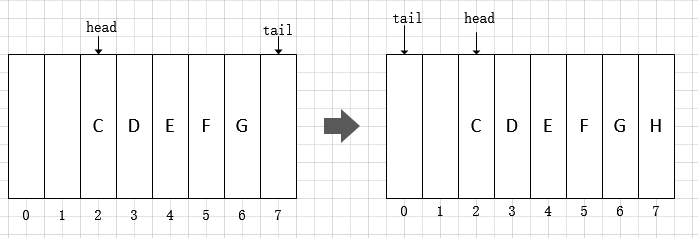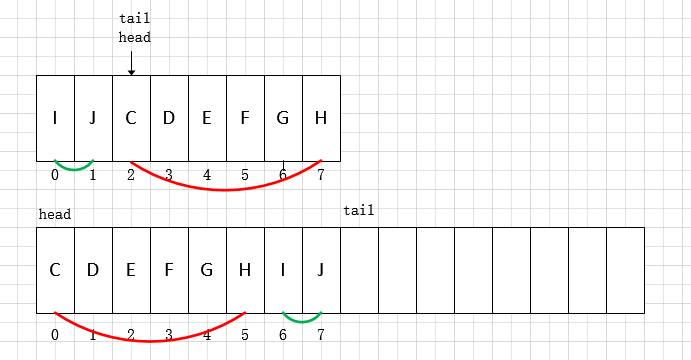Queue 也是 Java 集合框架中定義的一種介面,直接繼承自 Collection 介面。除了基本的 Collection 介面規定測操作外,Queue 介面還定義一組針對佇列的特殊操作。通常來說,Queue 是按照先進先出(FIFO)的方式來管理其中的元素的,但是優先佇列是一個例外。
Deque 介面繼承自 Queue介面,但 Deque 支援同時從兩端新增或移除元素,因此又被成為雙端佇列。鑑於此,Deque 介面的實現可以被當作 FIFO佇列使用,也可以當作LIFO佇列(棧)來使用。官方也是推薦使用 Deque 的實現來替代 Stack。
ArrayDeque 是 Deque 介面的一種具體實現,是依賴於可變陣列來實現的。ArrayDeque 沒有容量限制,可根據需求自動進行擴容。ArrayDeque不支援值為 null 的元素。
下面基於JDK 8中的實現對 ArrayDeque 加以分析。
方法概覽
1
|
public interface Queue<E> extends Collection<E> {
|
Deque 提供了雙端的插入與移除操作,如下表:
| First Element (Head) | Last Element (Tail) | |||
|---|---|---|---|---|
| Throws exception | Special value | Throws exception | Special value | |
| Insert | addFirst(e) | offerFirst(e) | addLast(e) | offerLast(e) |
| Remove | removeFirst() | pollFirst() | removeLast() | pollLast() |
| Examine | getFirst() | peekFirst() | getLast() | peekLast() |
Deque 和 Queue 方法的的對應關係如下:
| Queue Method | Equivalent Deque Method |
|---|---|
| add(e) | addLast(e) |
| offer(e) | offerLast(e) |
| remove() | removeFirst() |
| poll() | pollFirst() |
| element() | getFirst() |
| peek() | peekFirst() |
Deque 和 Stack 方法的對應關係如下:
| Stack Method | Equivalent Deque Method |
|---|---|
| push(e) | addFirst(e) |
| pop() | removeFirst() |
| peek() | peekFirst() |
ArrayList 實現了 Deque 介面中的所有方法。因為 ArrayList 會根據需求自動擴充容量,因而在插入元素的時候不會丟擲IllegalStateException異常。
底層結構
1
|
//用陣列儲存元素
|
在 ArrayDeque 底部是使用陣列儲存元素,同時還使用了兩個索引來表徵當前陣列的狀態,分別是 head 和 tail。head 是頭部元素的索引,但注意 tail 不是尾部元素的索引,而是尾部元素的下一位,即下一個將要被加入的元素的索引。
初始化
ArrayDeque 提供了三個構造方法,分別是預設容量,指定容量及依據給定的集合中的元素進行建立。預設容量為16。
1
|
public ArrayDeque() {
|
ArrayDeque 對陣列的大小(即佇列的容量)有特殊的要求,必須是 2^n。通過 allocateElements方法計算初始容量:
1
|
private void allocateElements(int numElements) {
|
>>>是無符號右移操作,|是位或操作,經過五次右移和位或操作可以保證得到大小為2^k-1的數。看一下這個例子:
1
|
0 0 0 0 1 ? ? ? ? ? //n
|
在進行5次位移操作和位或操作後就可以得到2^k-1,最後加1即可。這個實現還是很巧妙的。
新增元素
向末尾新增元素:
1
|
public void addLast(E e) {
|
這段程式碼中,(tail = (tail + 1) & (elements.length - 1)) == head這句有點難以理解。其實,在 ArrayDeque 中陣列是當作環形來使用的,索引0看作是緊挨著索引(length-1)之後的。參考下面的圖片:
那麼為什麼(tail + 1) & (elements.length - 1)就能保證按照環形取得正確的下一個索引值呢?這就和前面說到的 ArrayDeque 對容量的特殊要求有關了。下面對其正確性加以驗證:
1
|
length = 2^n,二進位制表示為: 第 n 位為1,低位 (n-1位) 全為0
|
可見,在容量保證為 2^n 的情況下,僅僅通過位與操作就可以完成環形索引的計算,而不需要進行邊界的判斷,在實現上更為高效。
向頭部新增元素的程式碼如下:
1
|
public void addFirst(E e) {
|
其它的諸如add,offer,offerFirst,offerLast等方法都是基於上面這兩個方法實現的,不再贅述。
擴容
在每次新增元素後,如果頭索引和尾部索引相遇,則說明陣列空間已滿,需要進行擴容操作。 ArrayDeque 每次擴容都會在原有的容量上翻倍,這也是對容量必須是2的冪次方的保證。
1
|
private void doubleCapacity() {
|
移除元素
ArrayDeque支援從頭尾兩端移除元素,remove方法是通過poll來實現的。因為是基於陣列的,在瞭解了環的原理後這段程式碼就比較容易理解了。
1
|
public E pollFirst() {
|
獲取隊頭和隊尾的元素
1
|
@SuppressWarnings("unchecked")
|
迭代器
ArrayDeque 在迭代是檢查併發修改並沒有使用類似於 ArrayList 等容器中使用的 modCount,而是通過尾部索引的來確定的。具體參考 next 方法中的註釋。但是這樣不一定能保證檢測到所有的併發修改情況,加入先移除了尾部元素,又新增了一個尾部元素,這種情況下迭代器是沒法檢測出來的。
1
|
private class DeqIterator implements Iterator<E> {
|
除了 DeqIterator,還有一個反向的迭代器 DescendingIterator,順序和 DeqIterator 相反。
小結
ArrayDeque 是 Deque 介面的一種具體實現,是依賴於可變陣列來實現的。ArrayDeque 沒有容量限制,可根據需求自動進行擴容。ArrayDeque 可以作為棧來使用,效率要高於 Stack;ArrayDeque 也可以作為佇列來使用,效率相較於基於雙向連結串列的 LinkedList 也要更好一些。注意,ArrayDeque 不支援為 null 的元素。

